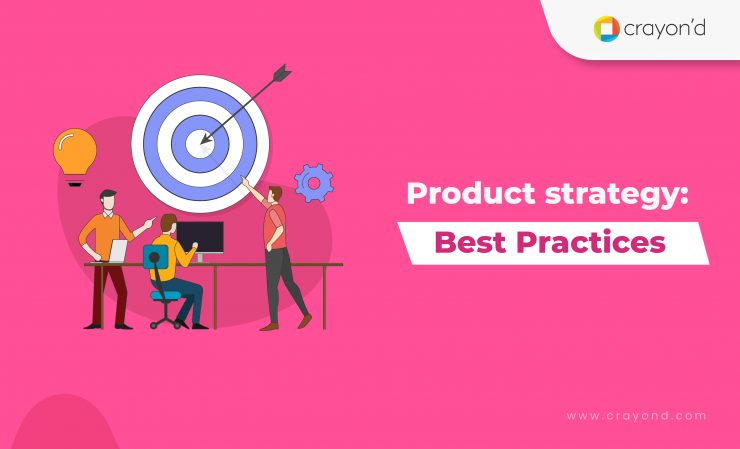Product strategy is extracted by putting a number of ingredients together. The process of strategy formation requires splitting your attention between too many spheres. You have to move back and forth amongst the elements.
In this tedious process, you might miss out on several details. But these details make a big difference to your product strategy. They aid in establishing the required clarity on the vision.
And, so you have to be aware. To help you out, here are a few best practices for product strategy. Go through and note them down to use them later during the creation process.
But, the tips have to be understandable and must be perceived the right way. And so, first, we’ll touch on ‘what product strategy is’ to bring in the correlation.
Product strategy — a brief definition
Product strategy defines the goals and business objectives your product should achieve and offers a high-level plan for that.
It is framed with these core elements— product vision, target market and competitors, product features, differentiation factors, and ultimately, the business goals.
Product strategy is the base from which you will be developing your product roadmap. The entire product team uses the roadmap that governs every individual’s work. Hence strategy directly or indirectly affects every task carried out.
Product strategy plays a crucial role in aligning the entire team toward the bigger picture. And if there’s any gap, product strategy is used to fill it up.
Product strategy carries huge responsibilities over its shoulder. You cannot possibly take risks with the framing part. One wrong move, it’s reflected everywhere, and it gets difficult to revoke. Make sure you do product strategy right, keeping the upcoming best practices.
5 best practices for your product strategy
1. Problem first, solution next
What is the problem with knowing that a problem exists?
Solution-focus.
It’s almost an involuntary action— when we, humans, are confronted with problems, we instantly shift our thoughts towards solutions.
Especially in the case of product development, you tend to get attached to the solutions you create. They might appear phenomenal to you. However, you shouldn’t be driven by that excitement and shift your attention from the problem.
You have to be in the problem zone for a while.
Your primary focus should be the PROBLEM, not the solutions. Have a deep dive into the problem– its causes and effects. Analyze the user problems from different viewpoints. Also, you have to think about the market, user, and business aspects.
You can come up with the best possible solutions only when you are clear about the user problem. A half-baked understanding of the problem will only yield half-witted solutions. Doesn’t it?
Problem clarity is what opens the door to solutions.
But, when it is natural, how do you avoid solution-first thinking?
Here’s a simple trick:
When you catch yourself thinking of solutions, you have to remember— it’s a trap.
2. Collect more ideas and opinions
After a deep dive, swim, and immersion in the problem sea, you’ll finally come to the solution part.
While understanding the problem plays a key role, it’s the solution that will carry your brand across the users. Well, the solution is your product. And it cannot be anything less than perfect.
But you don’t land on perfect solutions right away. Do you?
A lot of brainstorming needs to happen at this point. Try to take note of every other idea thrown. Don’t get into analyzing the ideas here— whether or not they’ll work. Feasibility matters, but not at this point. You’ll get to work it out in later stages anyway.
Focus on getting as many ideas and perspectives. Let the thinking happen first, it doesn’t matter if it’s logical or realizable. Such criteria can put pressure on the thinking front.
Let the ideas flow at this point and eventually, you’ll end up with the best amongst them.
3. Collaboration makes the difference
“Nothing great is ever achieved alone” — John C. Maxwell.
Product strategy cuts across every team and influences their work. Looping in those team members during product strategy creation can aid you in many ways.
Teams though they contribute to one process, have different natures of work. Thus they face diverse challenges and follow unique ways to approach their work.
Involving them here can bring their difficulties to light. It paves the way for the mindful development of product strategy. Also, discussing the problems with the team can fetch you their suggestions and solutions. You never know where a good idea can come from. Collaborations bring you these benefits.
Wait, there’s more– collaborations during such early stages of strategy formulations result in a better understanding. Teams know how strategy is put together. They can relate to the core idea making the bigger picture easy to perceive.
Also, the strategy should not just work out for individual teams. It should be seamless when they come together— be it for 2 or multiple teams. Early-stage collaborations remove these hurdles since the view of every team is taken into account.
4. Stay agile
The innate nature of market and customer needs is that they are ever-changing. The product offering should accommodate this change as quickly as possible to stay competitive and relative to the users.
If your product strategy is rigid, you might be unable to keep up. While framing the product strategy, you must ensure that it’s built, leaving room for transformations.
The strategy should enable you to grow and disrupt when needed. There are only predictions on what tomorrow will bring. We can never foresee certain situations like the pandemic— that appear out of the blue.
Even in the absence of these situations, products go through a lifecycle. And that requires new strategies and angles. One size fits all doesn’t work here. Revisiting and updating the product strategy should be a regular part of your process.
The strategy should power you to turn over a new leaf when such situations arise. Incorporate agility into your product strategy and in handling them as well.
5. Define the right success metrics
Product strategy doesn’t confine itself to product development alone. It spans the entire product life cycle— which includes measuring the product performance and making tweaks along the way.
And for that, you need to know what success looks like in terms of product performance and market reach. The purpose of strategy is not in setting the right path alone. But enabling ways to move forward in that direction.
Define the right success metrics. It can help the team check whether or not they are on track. While you don’t have to go in-depth, you can define overall success in the form of OKRs.
Make sure the defined OKRs give a true reflection of your product’s performance. There shouldn’t be any gap or mismatch here. It causes a big impact on the product’s growth curve.
Endnote
The key to building the right product strategy is knowing what a strategy is and what is not.
Your product strategy isn’t as broad as the product vision. Nor is it as detailed as a roadmap. You don’t define micro-level plans or tasks to be executed in the strategy.
Product strategy adds specifics to your product vision and sets a defined direction to achieve it. It is the starting point of execution and connects the product vision with the product roadmap.
This clarity is what you need to have when starting with your product strategy exercise.







Add comment